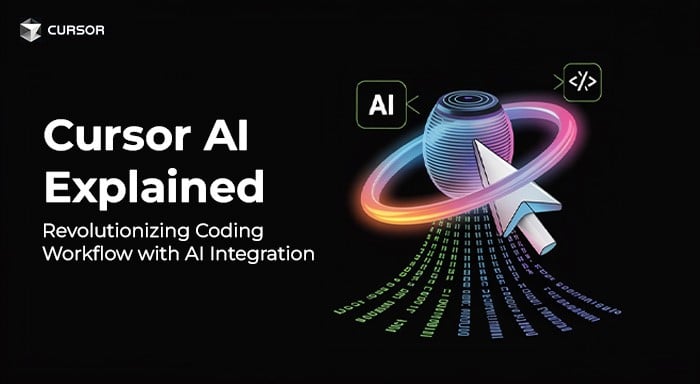Artificial intelligence has revolutionized a wide range of industries, automates tedious tasks, streamlines workflow, and enhances the overall outcome. Regardless of whether you are a creator, marketing professional, or developer, AI-powered tools not only save your time but also boost productivity. However, Cursor AI is one such innovation that transforms the world of coding and project development environments. It has become the first AI code editor that leverages GPT-4 and other advanced AI model capabilities to help you write code faster.
This groundbreaking platform is designed on VS Code Studio, which facilitates a similar interface and inbuilt tools. Consequently, it has become one of the most popular code editors among developers that offers smart suggestions, error detection, and refactoring code. While it offers extensive features and automation tools, it may not effectively function for large or complex projects. Then the platform generates irrelevant codes and inaccurate suggestions and can’t debug the code in real-time environments.
Hence, this blog will cover what cursor AI exactly means, how it works, its features, and some practical examples. You will also learn the installation guide and best practices to utilise the most out of it. Let’s get started!
What do you mean by Cursor AI?
Cursor AI is an advent as an IDE (Integrated Development Environment) powered by artificial intelligence that streamlines the coding workflow. This platform offers an AI assistant feature that helps you write, debug, and interpret the code in simple language. VS Code integration provides a simple and intuitive interface that enables both experienced professionals and beginners with minimal coding knowledge. Users can also create entire code by entering the description of what they want, and the platform generates an accurate program within seconds.
Primarily, the platform leverages machine learning and AI models, like ChatGPT and Claude 3.5, to understand prompts and generate code. With its AI-driven code completion, real-time suggestions, and detailed code explanations feature, the platform has gained traction in recent years. This sets it apart from other conventional platforms, making it faster, accurate, and 24/7 available.
Key Features of the platform
What makes Cursor AI different from other conventional editors? This AI-driven platform offers a wide range of features that help developers and technical students to streamline the coding process. Here is the list of features:
- Auto Code Completion: Unlike passive editors which focus on current lines, cursor AI supports auto-completion features based on multi-line evaluation. This provides simple, accurate suggestions by analyzing the overall project structure, function, and used libraries.
- Code Generation using Commands: Want to generate a recursive function to solve a complex problem? Ask the editor. The AI generates efficient, contextually correct code within a few seconds. This helps users to implement their code logic into practical solutions.
- Error Detection and Debugging: The smart automation enables the editor to consistently scan the code and flag errors. This includes logical flaws, syntax errors, compile-time and run-time errors. This real-time detection can ensure the smooth flow of code and prevent errors.
- Multi-language Support: Cursor AI provides strong multilingual support like Python, JavaScript, C++, TypeScript, and more. The advanced AI model provides flexibility that encompasses suggestions for syntax, functions, and logic tailored to each language.
- Third-party integration: This AI-driven platform supports third-party integration through SDK and API gateways for improving customer experience. With this feature, developers can now connect various AI models like ChatGPT, Claude 3.5, GitHub, and even web resources by simply putting link as a prefix for @.
- Documentation Generation: The platform offers auto document generation features based on your code, saving time and reducing operational challenges. With this, users can add external documents, use prescribed documentation or create their own documentation tailored to their codebase.
Also Read
Getimg AI – An All-in-one Solution for AI Image Generation and Editing
Talkie AI: Understanding the Evolution and Implications of Conversational AI Technology
Suno AI: Revolutionizing Business Marketing and Branding
How It Works?
At its foundation, Cursor AI uses natural language processing to analyse the command prompt and generate code while maintaining context. With AI integration capabilities, this creates and fixes errors in real-time, along with writing code, creating functions, and optimising the structure of the program. Its multilingual support allows users to write code in various languages, including Python, JavaScript, TypeScript, and many more. This enables users to build web applications, machine learning models, and backend systems seamlessly. During the code-writing process, the system assists users by suggesting functions, variables, and indentation.
Installation Guide: How to Install Cursor AI
Before diving deep into the installation process, make sure your system meets the following guidelines:
- Fast, reliable internet connection for initial setup
- X64-based processors, ideal for multitasking
- Minimum 4 GB RAM (8GB recommended for smooth performance)
- Minimum 500 MB free storage (can vary for large projects)
The Cursor AI installation on Windows and macOS is a straightforward process, like installing other programs. This may support a graphical installer, meaning we simply install it from their home page and download the file with .exe (for Windows) and .dmg (for macOS) extensions.
In Linux, the process often comes with complexities and challenges like dependency errors and permission issues. Typically, it supports .AppImage or .deb file extension. For executing the file type, users need to execute commands using terminals or package managers.
Let’s explore the step-by-step installation process for each operating system:
For Windows and macOS:
- Download & Install Cursor
Navigate to the Cursor AI official website (www.cursor.so) and download the .exe or .dmg installer file. Then go to the downloaded file section on your browser and double-click the file to start the oath installation process.
- Run and Lunch the Installer
To launch the installer, follow the instruction given on the interface
Click “next” button--> Choose a path
Once the process is done! Cursor will automatically launch on your system.
- Set Up the Environment and API
Therefore, the platform requires you to create an account using GitHub, Google, and Email. Choose your preferred method from them and verify it. Additionally, integrate APIs to optimize the functionality by entering the API key into the Cursor AI “API integration” settings.
Note: Since the platform is not from App store, it may ask for permission for mac users. You can approve it from,
System Preferences -> Security & privacy -> General
- Test the platform:
Before starting out, first test the platform with small projects to check whether it meets your specific requirements. If not, then adjust themes, fonts, and keyword settings through its advanced customisation feature.
For Linux:
- Visit the cursor AI official website and download the installer file with .deb or .AppImage extension.
- To execute the file, open a terminal and run the following command.
Sudo dpkg – i cursor*.deb
- If dependency issue occurs, run this command
Sudo apt-get install -f
- After installation, launch Cursor by entering cursor in the terminal or via the application menu.
- Then log in using preferred methods and test the platform to check the compatibility of the platform.
Final Thoughts: Is Cursor AI the future?
In the fast-paced world of today, Cursor AI has become the smartest automation in the coding and development landscape. By integrating ChatGPT and Claude 3.5, the AI-driven platform can streamline the overall coding experience, eliminating the need to switch platforms. This provides a wide array of features, like writing, debugging, and refactoring code or giving suggestions for various programming languages, or even interpreting the code in natural language.
However, the platform is designed within the VS Code environment, which makes it an effective, popular IDE for small projects. In contrast, its ineffectiveness for large, complex projects may cause a critical issue among developers. The AI platform struggles with high-cost pricing, performance issues, privacy concerns, and a difficult learning process.
With its robust feature set and advanced automation, most developers raise the concern that it replaces the human developer. However, Cursor AI enhances their capability by providing a fast, efficient, and strategic way to write code. Whether you are a developer or tech-savvy learner, experimenting with this AI-powered code assistance platform can mean the world of difference. Try and test the platform to decide whether you must use it or not.



